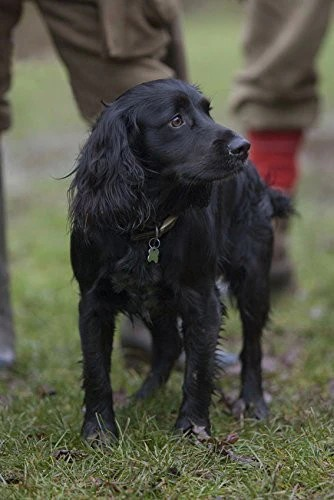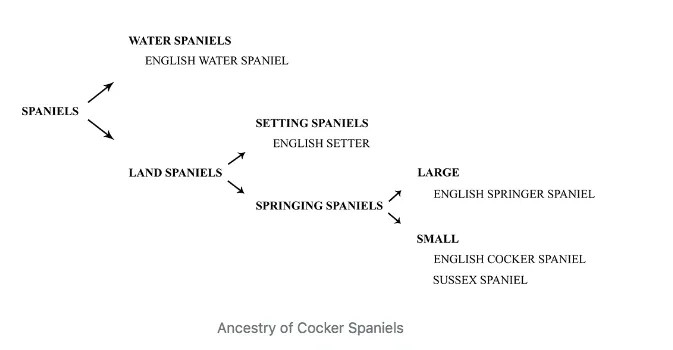Let’s talk about Spaniels…
We as a rescue are seeing more and more people on the look out for Spaniels. Of course, rescues can and do have Spaniels (sadly they are dumped as many find them too high maintenance) but it’s not a rule that we would get this breed of dog in at all, let alone with any regularity. They have been a popular breed, sometimes the most popular, for over a century in many cases now, so it’s hardly surprising they would do yet another comeback with adopters.
Same with cockerpoos, cavapoos and all the other 'made up' spaniel mix breeds… adopters wanting these dogs are also on the rise, partly due to low shedding reputations (which is a whole other blog!)
But they can be great dogs, for the right human(s). So here’s a dog blog on Spaniels and what you could be taking on.
Know your Spaniels!
As the name might suggest, Spaniels likely originate in Spain, or least enough people thought so to call them ’the Spanish dogs'. But the dog we think of when we see Spaniels in our minds is the cocker Spaniel for the most part, which was developed and became very popular from about 400 years ago in England,
though they seem to have been around since Roman times here at least (but may have originated in Egypt) so may have come to England with the Roman armies two thousand or so years ago
But it was in the 1600s in England when the specialised breeding really started. Firstly into water and land breeds.
The English water Spaniel is now extinct though you can still get Irish US and Portuguese varieties, but was used to retrieve water fowl shot down with arrows.
Land spaniels could be
'setting spaniels'—those that acted like ‘pointers’ or ‘setters’ (of which there are other actual breeds or course) and showed where the game was, allowing hunters to ensnare them with nets, and
'springing spaniels'—those that sprang (forced out of hiding) pheasants and partridges for hunting with falcons, and rabbits for hunting with greyhounds. Now these can be great with kids but most people equate smaller dog to being a better-with-kids dog and many migrate towards cockers instead. But we are still not seeing them as pets here. This is very much a working dog from the start. Of course, nowadays there are Welsh and English varieties of Springer Spaniel too.
So a high prey drive was desired, with obedience, and bred into these working dogs. So alongside that prey drive, the need was bred in for a soft mouth and self discipline so as not to damage or eat the prey when bringing it back to their ‘owner’.
This lack of a natural tendency to want to snap like other smaller dogs often attracts families with children, which is understandable, burt don’t rely on it. Any dog will bite a kid if they keep poking it or pulling its tail! One particularly awful true story was of a young Spaniel who'd just 'gone mad' biting people, and at the autopsy they found an entire pencil rammed right into the dog's ear canal likely by one of the kids! Never leave your children, especially very young kids, with a dog unattended! And don’t rely on that or any dog's self discipline not to bite a child who won't leave them alone, or not to steal the odd steak from the kitchen counter if it’s in reach, without firm and consistent training… the nose leads these dogs.
Any springer spaniels that bred naturally smallest ended up being what we now think of as cocker spaniels (and ones that tended to be in between, Sussex Spaniels).
And as gun based hunting became more popular, Spaniels’ skills were honed further into proper ‘gun dogs’. So those cute little cockers still love to chase the birds and small furries to this day!
Roll on about 200 years, when the splits in the breed were so obvious that the Kennel Club recognised them as different breeds within the Spaniel label. And the tail docking started,
a practice we are totally against in pets or for fashion but understand can be necessary in working/gun dogs, and ratters too. And from the 1900s, their popularity exploded, with their natural cuteness leading to a lot of unscrupulous breeding and unsuspecting families taking them home only to find they were happiest out, and constantly stimulated, like the working dog they truly were…
While Cockers (US ones are smaller, UK ones are bigger) do do better than Springers in apartments as they do enjoy a snooze, they are very active too and not always to be recommended as first time dogs, especially around children who are also experiencing a pet for the first time- they are high energy, they WILL jump up, and while family oriented do not always gravitate to kids. Their happy dispositions often can make people think they are the perfect first time dog but this is not necessarily the case, like all spaniels they need a lot of walks, and SOMETHING TO DO, and they do not always do well if having to be left alone by a busy family at work and school. However, they were bred to be smart, food led as rewards, and easy to train, provided the adopter makes the training goal based due to their questing dispositions.
The ‘water spaniel’ may be extinct as an English breed strain, but it’s still in the genes, and you may well get a swimmer (and a mudhole lover!) so the fact they need daily grooming to those lovely coats, and the fact professional grooming is also advised needs to be taken into account. We would be far more likely, should we get any cocker mixes in, to recommend to experienced families, couples with no kids, or people who are solo, provided they lead a very active lifestyle. Also in the genes are a whole stack of health conditions- ears and eye issues, heart disease, slipped discs and pancreatitis are health issues to be borne in mind with a pure breed Spaniel, and to be borne in mind with mixes too. The PDSA has more on the health issues Spaniels in general may have here and other useful Spaniel info.
All the gun dogs- your Spaniel belongs to this group of dog breeds- credit https://www.101dogbreeds.com/working/gun-dogs
Now onto Cavalier King Charles Spaniels- are these the sweet little easy going lapdogs everyone’s thinking of when they say Spaniel?
Finally recognised as a breed in 1945, nobody is quite sure whether they were made popular by King Charles II or developed by his husbandry staff, but more recently they come partly from an extinct sub toy breed called Toy Trawler (a failed mix of the Sussex Spaniel and alleged descendants of Charles II’s dogs) and come in black and white, or red (also called ‘liver') and white (Blenheim). The ‘original’ CKCs were famed for following Charles round his castle(s), being lapdogs all day; were notoriously spoiled and not toilet trained! But make no mistake, they were bred for hunting especially more recently, and their stamina was bred into them to keep up with horses. So expect long walks here too- a good hour a day. (Young pups need to build up to walks so as not to damage growing muscles and cartilage.)
But by the 1920s they were almost extinct till Roswell Eldridge placed an ad in a dog-show catalogue that dared British breeders to bring a 'royal breed' back from the brink of extinction. The flatter faces and domed foreheads we know now were bred in since then for ‘fashion', and a fascination with oriental breeds like pugs and chins. So yes while there is far more likelihood of CKCs (called English Toy Spaniels in the US) being lapdogs, they have similar origins and have hunting in the genes.
Firstly, this is a rare breed. Also these dogs are BIG. Like 35kg plus big,or can be. And they SLOBBER. They are very distinctive in the show ring and known for competing in tracking, obedience, rally, and other dog sports. They are not in the gun dog category of breeds but are considered a ‘sporting’ dog. They are actually often seen as better family pets than the other types of Spaniel, are more calm and easy going, less bouncy and happy to plod along on a walk of 20-30 minutes or so a day once the puppy stage has passed and is walk trained. Clumbers are often thought as a good dog even for novices despite their size because of their laid back nature. But these too can be distracted by birds and other small animals when out and about. They too can like a swim, and they have a heavy long coat that means they do well in colder climes too. They do like to carry things, even on walks. They are heavy shedders and need a lot of grooming. For more on Clumbers check out this link.
While this is by no means a complete list of Spaniels, does any of this sounding like a dog that’s naturally good around children and small pets yet?
Work would have to be put in, the same as any other dog or pup, with careful and calm introductions, to ensure a happy home with any dog and child and.or other pets in it; it’s not going to be walk in like a Disney dog just because you get a Spaniel or Spaniel mix.
They could be the best family member ever, or a destructive nightmare- and that part is up to you!
Just because they look cute and little does not mean they are the dog for you. You need to
love long walks,
do plenty of recall training
and maintain their interest with food, new smells and experiences.
They aren’t likely to guard your home, and you need to brush them every day, but you may well be licked to death when you come home from work and have a limpet for the rest of the night. And they will chew when stressed or bored! So do your research, manage your expectations and be realistic- make sure you’re not just falling for that pretty face and you can be the family to provide what the dog needs to be happy and healthy.
More reading
For more on the origin of this fascinating, but challenging breed(s) of dog, try https://janedogs.com/history-of-spaniels/











